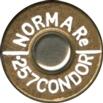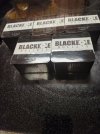This IS a new/old wildcat:
View attachment 495505
This is the original story about the 257 Condor taken from
GUNS MAGAZINE, Jan 1960
When a competent engineer decides to design a wildcat cartridge, some old ideas are given some new twists. The usual wildcatter reshapes an existing case, uses existing components, and the gunsmith chambers an existing barrel. Sometimes the loads are actually chronographed; and, rarely pressure tests are made. Sensational figures are arrived at, the new cartridge is given a fanciful name, and the proud originator is in business with a new wildcat. The story .on the .257 Condor is quite different. In 1946, Dr Ramon Somavia conceived the idea that a projectile of unusually high sectional density would exhibit unusual ballistic characteristics, and he set out to prove it. Now, fifty barrels and many years later the .257 Condor is a reality and no longer a wildcat. The name is copyrighted, patents have been applied for on the design; and the cartridges, the cases, and the special bullets are readily available to the shooter or the hand loader here, from Norma-Precision, Inc., South Lansing, New York. The Somavia Ranch near Hollister, Calif., is one reason for the Condor design. Deer are numerous on those rolling grassy hills, but the choicer ones always seem to be five hundred yards out, with little cover from which to stalk them. Hence, the first requisite was a cartridge which would show a flat trajectory. Second, since Dr. Somavia does considerable hunting in Alaska, and Canada, the cartridge must be certain on heavy game animals. Flat trajectory must be achieved without the excessively high velocity which blows up 8-bullet on the hide or the first large bone encountered.
Deep penetration was wanted. Muzzle velocity is impressive on paper, but velocity which counts is that delivered to the animal a few hundred yards out. Hunters have noticed that the 7×57 Mauser 175 grain bullet, and the 6.5 mm. Mannlicher•Schoenauer 160 grain bullet exhibited killing qualities out of all proportion to their size or paper ballistics. They also showed a lot of remaining velocity, compared to modest initial velocity. After a number of experiments with a .30 caliber, the decision was made to go to a .25 caliber with a 160 grain bullet. Calculation indicated a rifling pitch of 6lh inches would stabilize the bullet, but testing determined that better accuracy and velocity were achieved with a 7 inch pitch. Very short cases developed more pressure than a longer one of the same capacity. Efficiency increased as shoulder angles approached 30 degrees; but with the angle sharpened excessively it was found that combustion was increasingly more difficult to control, with the powder charge being very critical, developing sudden pressure peaks. Hence, the shoulder angle was cut back and given a semi-venturi shape. The belted Magnum case was cut to .30-'06 length so it would function in a standard action, and was shaped to hold 64 grains of average IMR powder to the shoulder.
Once off the beaten track, the experimenter encounters many difficulties. With the required rapid-pitch rifling, at an effective velocity, the bullets disintegrated in the air. In the long bearing surface bullets, cores were melting through excessive bore friction. Centrifugal force from spin then exploded them. Tested was a two-diameter bullet, with little improvement; then solid copper bullets. Made to original dimensions, they weighted only 145 grains. Disintegration stopped, but the light bullet lost velocity so rapidly that it was nose-diving beyond 300 yards. With no practical way of reducing bore friction or centrifugal force, it seemed to me that the only way out lay in reducing the heat transfer which was melting .bullet cores. Copper jackets transmit heat rapidly, so I suggested the use of steel jackets. Atkinson & Marquart in Prescott, Arizona, made swaging dies and a supply of steel jacketed bullets using Shelby tubing. These bullets proved the theory, stopping disintegration, maintaining good trajectory, and giving sensational results on game. But best Shelby tubing available proved to be far from uniform in hardness, so accuracy suffered, and the bare steel bullets were a bit rough on bores. One barrel washed out completely with 207 rounds.
We tried to get a bullet maker to furnish bullets jacketed with Trio-Metal, like the Government .30 M-2 Alternate bullet or the Norma match bullet. These steel jackets have a layer of Gilding Metal on either side, the inner layer protecting the drawing punches while the outer protects the bore. No bullet makers in this country were found willing to tackle the problem. Amund Enger, President of Norma-Projektilfabrik in Sweden then accepted the project. An order was placed with the Swedish firm of E. H. Sheldon of Norma-Precision in South Lansing, New York, for 100,000 bullets, 12,000 cases, and 500 boxes of loaded cartridges. Test barrels and the chamber reamers for making more barrels and a pressure gun barrel were shipped to Sweden. Norma finally solved the problem in drawing the long 160 grain steel bullet cups; then speedily filled the contract. Swedish powders proved useable, and pressure and velocity tests showed that the American powders best adapted to the new cartridge are IMR #4350, LVlR #4831, H•570, and Machine Gun powder. Erosion being still a problem, tests were made on barrel steels by George Hageman, well known California Bench Rest Shooter. Groups were fired within time limits, so that the barrels would heat up, approximating actual use.
It was found that the usual SAE #4140 Chrome Molybdenum barrel would wash out with 300 shots. Timken barrel steel then was tried. With a normal cartridge such as the .30•'06, this has given much the same useful life as SAE #4140 steel; while under conditions of high erosion, it was fired with 1000 cartridges of .257 Condor caliber. Then an additional 25 cartridges were fired on a target, to give a minute of angle group. This barrel was then cut for inspection, revealing an advance of the forcing cone or "Ieed" plus considerable heat•checking, but no major gas wash•out in the rifling throat. Beyond 5″ from the chamber, the rifling was in good condition. Maintaining a land diameter of .250″, various groove depths were tried. At .256″, pressure ran high while velocity dropped. The .257″ groove diameter proved useable; but a groove diameter of .258″ showed a velocity gain of approximately 200 feet per second at the same pressure, with no loss of accuracy. At .259″ groove diameter, pressure dropped more but groups started to enlarge. Rifles were then made up for testing on game. One was taken to Alaska and the Yukon, where nine caribou were shot. With deer numerous on the Somavia Ranch, visiting friends tried the Condor on them during the California open season. The wild burro, tough and lethargic, is difficult to convince that he is dead. He is unprotected in Arizona, so we tested the new rifle on this noblest varmint of them all.
With a hit in other than a very vital spot, not even the .357 Magnum would give a quick kill. Feeling that hits directly on vital spots with any sizeable caliber would quickly drop an animal, we concentrated on making poor hits. Some few deer were hit thru the chest area, but a majority of all the game was deliberately paunch-shot or struck thru the hips. To the dismay of the guide, some of the caribou were paunched. Regardless of the location of any solid hit, or the size of the animal, the reaction was almost invariably the same. It would stop, appear dazed for an interval of fifteen or twenty seconds, back up a few steps, and then collapse. We attribute this unusual reaction to the high rotational spin of the bullet. First, there is almost inevitably a certain amount of yawing or cork-screwing when a very long bullet is spun fast, to create the effect of a larger-diameter bullet. The high rate of spin causes the particles of immediately displaced tissue to become secondary projectiles, to cause wide wound damage and to paralyze nerve centres. That one of the primary aims of deep penetration in a heavy animal was achieved is evidenced by the fact that few of these bullets have been recovered. As evidence of flat trajectory, when this rifle is sighted in at 200 yards, the point of impact is ¥2 inch above the point of aim at 100 yards. Sighted in for 300 yards, that point of impact is 2 inches high at 100 yards.
Chronograph results at 20 feet indicate accurate loads using various powders run a mean of approximately 2900 f.p.s. with the 160 grain Norma bullet. With 54.5 grains IMR #4350 and Winchester #120 primers, five shots bracketed 2902-2945 f.p.s. with an average velocity of 2918 f.p.s. Using IMR #4831,57 grains, and Federal #210 primers, five shots averaged out 2919 f.p.s. with a velocity spread of 27 f.p.s. Using Remington #9Y2 primers and 64 grains Machine Gun powder, velocity averaged 2844 f.p.s. and with the same load and Federal #215, the average velocity was a little hotter, 2893 f.p.s. A top load of 60 grains IMR #4350 backing the 120 grain Norma bullet using Federal 210s yielded an average velocity of 3394 f.p.s. with a low of 3375 and a high for five shots of 3436 f.p.s. The .257 Condor is a rifle for use on the heaviest American game, particularly at the longer ranges. It isn't primarily a varmint rifle, although it shows high velocity with a 120 grain bullet, while retaining good accuracy. With either bullet, recoil is light, about 15 foot pounds with the heaviest loading and the 160 grain bullet in a seven pound rifle. "Condor" is copyrighted, and may be used only under license. Patents have been applied for on the cartridge, with the claims based on the principle of the high rotational spin of the bullet giving aerodynamic lift, to contribute to the flat trajectory. American and Canadian rights to the Condor have been retained by Dr. Somavia. Other foreign rights have been assigned to AB Norma Projektilfabrik. National U. S. distributor is Fred F. Wells, 514 West Gurley Street, Prescott, Arizona. He will license shops to build the Condor and use the name. Some rifle builders already licensed are Adobe Walls Gun Shop, 2411 Wilshire Blvd., Santa Monica, Cal.



